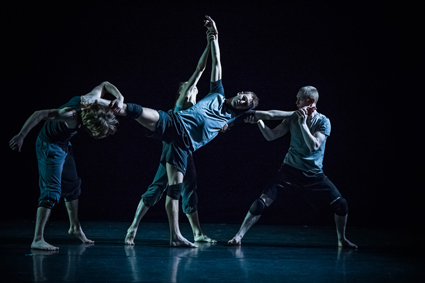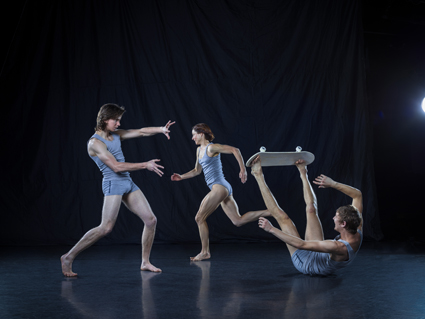 |
Skeleton, Larrisa MacGowan photo Chris Herzfeld, Camlight Productions |
The work draws inspiration from Ricky Swallow’s sculptures, specifically those involving skulls and 80s paraphernalia. This is a tricky point to leap from. A vital feature of Swallow’s art is his ironic use of monumentality—making the unimportant extravagantly important, the practical completely impractical. It is a feature that is, to a certain extent, predicated on his medium, which is static and timeless. The theatre—kinetic and ephemeral—is a different beast entirely.
Nevertheless, Larissa McGowan and Sam Haren’s subsequent vision for Skeleton is of an “archaeological puzzle” that fleshes out the human frame with the muscle of pop culture. Unfortunately, the skeleton and the muscle end up running parallel. McGowan’s choreography carves out the physical concreteness of the skeleton in the present tense, whereas the pop culture exists merely as artefact, never truly coming alive. These artefacts include an all-white BMX that directly quotes Swallow’s famous 1999 work “Peugeot Taipan, Commemorative Model (Discontinued Line).” Lisa Griffiths’ intricate dance with the bike is expert in its execution but the interaction is not affecting, for her or for us. The archaeology of culture is not merely the digging up of urns, it is also the contextualising of the urn. And, though the props are skateboards and stilettos and the sound design is littered with Nintendo bleeps and horror movie howls, the work as a whole fails to build a context for these references, stripping them of meaning.
McGowan’s choreography bears the hallmarks of her time with Australian Dance Theatre. It is fast, explosive and at its best when the speed and forcefulness catch the viewer by surprise. Softness is not part of the vocabulary, nor should it be, given the subject matter. McGowan extends the dancers’ bodies as though from within them, the internal physical mechanics becoming apparent. And there seems to be a recurring motif of bodily disassociation, where the intention of the mind and the action of the body run counter to one another. We see this in Lewis Rankin’s frenzied solo, in Griffiths’ suddenly stiffened muscles. The choreographic language is rooted in the mechanical and, importantly, it is firmly internal.
The dynamics between the dancers are similarly mechanical. There is no engagement, nor relationship between them beyond emotionless grappling. This isolates the dancers from one another, creating spatial pockets of action rather than a stage full of tension, love, contempt or any other of a host of intangibles that can imbue the space between people with meaning. This, in itself, is not necessarily a negative, but the isolation here feeds into the larger, more crucial problem of the show’s parallel themes not interacting.
 |
Tobiah Booth-Remmers, Lisa Griffiths, Lewis Rankin, Skeleton photo Chris Herzfeld, Camlight Productions |
Similarly, Jethro Woodward’s sound design is often a remarkable assault of mashed-up film foley sounds. The splatter, the gore, the piercing screams are punched together so quickly that they become their own delicious music. However, as they lose their distinctness they also lose some of their ironic humour and the chance to juxtapose contrary or incongruous references is also missed. Occasionally, the engagement between the dancers’ bodies and the score approaches the well-worn path of fighting to sound effects (recall the martial arts scene of Chunky Move’sTense Dave, 2003). McGowan steers away from that course for the most part, but the result feels like a compromise rather than a strong alternative.
In the end, the real strengths of Skeleton—the internal electricity of McGowan’s choreography, the dedication of the dancers, the magic of the black screens—cannot sustain a full-length show. The bones are willing but the flesh is weak.
Dance Massive, Malthouse: Skeleton, choreographer Larissa McGowan, directors Sam Haren, Larissa McGowan, performers Tobiah Booth-Remmers, Lisa Griffiths, Marcus Louend, Larissa McGowan, Lewis Rankin, set, costume design Jonathon Oxlade, lighting Bosco Shaw, Bluebottle, composer: Jethro Woodward, producer Freya Waterson, Insite Arts, Beckett Theatre, Malthouse, Melbourne, March 14 - 23; http://dancemassive.com.au/
RealTime issue #114 April-May 2013 pg. 31
© Carl Nilsson-Polias; for permission to reproduce apply to [email protected]








 back
back